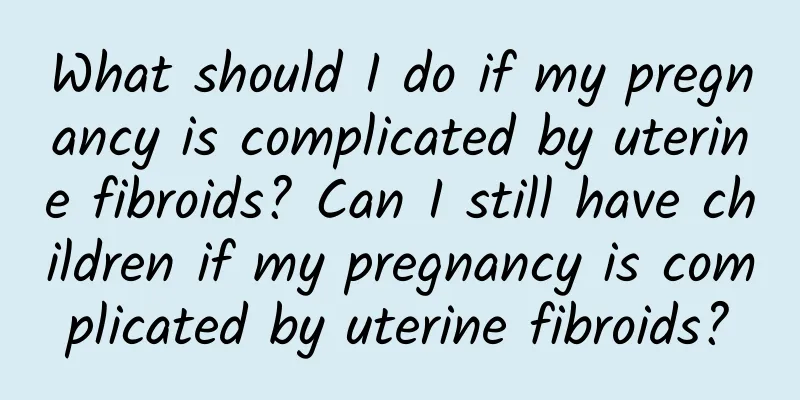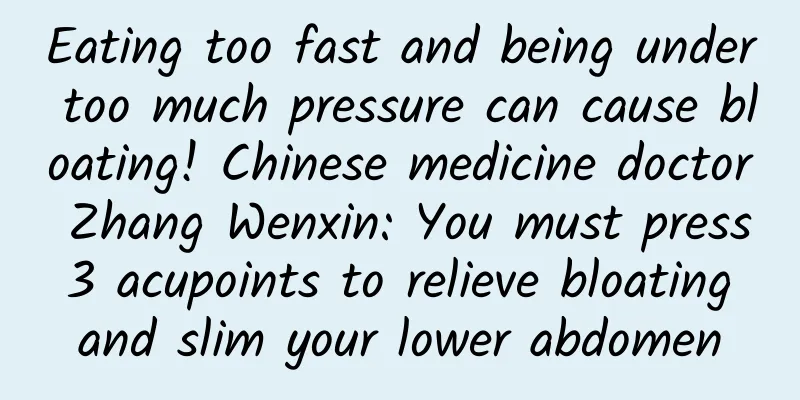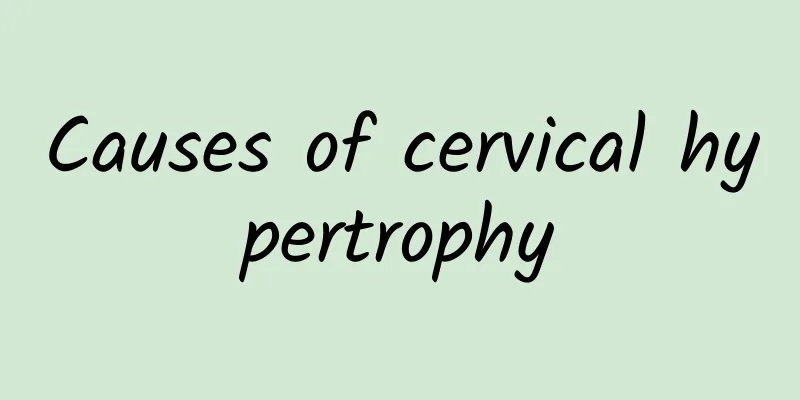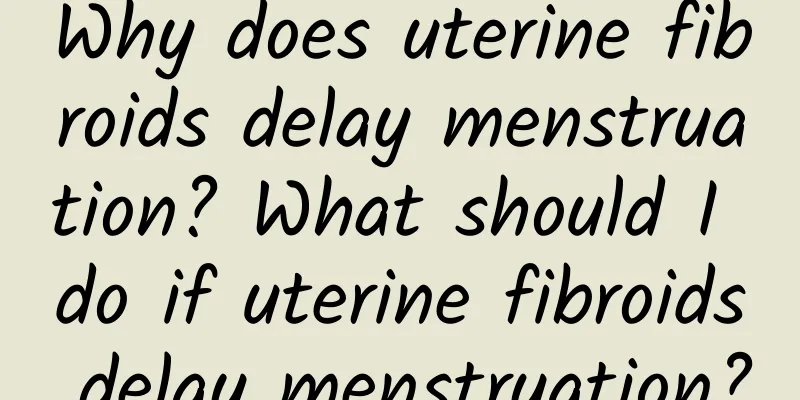What should I do if my pregnancy is complicated by uterine fibroids? Can I still have children if my pregnancy is complicated by uterine fibroids?

|
Uterine fibroids are common benign tumors in women of childbearing age. Patients with multiple uterine fibroids are often accompanied by infertility, and sometimes the infertility rate can reach 40%. Uterine fibroids mostly occur in women aged 24 to 46, and most occur between 26 and 40 years old. Although some pregnant women have uterine fibroids, they can still continue their pregnancy to full term and give birth smoothly. Once pregnant, fibroids will grow rapidly with the growth of the uterus, especially after the second trimester of pregnancy, they will "degenerate", with symptoms such as abdominal pain and fever. Uterine fibroids can sometimes lead to miscarriage and premature birth. The hazards of pregnancy complicated with uterine fibroids Pregnancy complicated by uterine fibroids has an impact on pregnancy and delivery. Submucosal fibroids hinder the implantation of fertilized eggs or early miscarriage. Large intramural fibroids are also prone to miscarriage due to mechanical obstacles or uterine cavity malformations. During pregnancy, the uterus is congested, tissue edema, smooth muscle cell hypertrophy, and fibroids are significantly enlarged, which gradually decreases after delivery. Fibroids grow rapidly during pregnancy, and red changes, severe abdominal pain, nausea, vomiting, fever, and increased white blood cell count may occur. After diagnosis, conservative treatment is used without surgery. Subserosal fibroids may undergo chronic or acute pedicle torsion, leading to fibroid necrosis, infection, suppuration, etc. Larger fibroids during pregnancy can lead to abnormal fetal position, intrauterine growth retardation, low placenta or previa. During delivery, obstruction of the birth canal and difficulty in prenatal exposure may occur, leading to dystocia. It can also cause fatigue of uterine contraction, prolonged labor, postpartum hemorrhage, etc. When to treat uterine fibroids? If uterine fibroids are combined in early and mid-pregnancy, regular check-ups should be conducted at obstetric hospitals and close observation should be conducted without premature treatment. Due to myomectomy during pregnancy, there is a risk of miscarriage, premature birth, and uterine rupture. At 36 weeks of pregnancy, the doctor should decide on the mode of delivery based on the location of the fibroids, the condition of the fetus and the pregnant woman. If the uterine fibroids are located in the lower part of the uterus, the birth canal is blocked, and the fetal head cannot enter the pelvic cavity, a cesarean section should be selected. Whether the uterine fibroids are removed at the same time during cesarean section depends on the size, location, maternal condition, and technical conditions of the equipment. If the uterine fibroids are located near the uterine incision, are submucosal fibroids, or have a small base, myomectomy can be considered at the same time. For larger myomectomy, excessive bleeding is likely to occur, increasing puerperal infection. If the uterine fibroids are small, they will not affect the delivery process, and vaginal delivery can also be successful. Red degenerative uterine fibroids During pregnancy, due to the influence of hormones and tissue edema, uterine fibroids grow rapidly and are prone to degenerative changes. Due to the rapid increase in the size of the fibroids, rupture of blood vessels, and the spread of bleeding into the tissues, uterine fibroids are prone to red degeneration during pregnancy and the puerperium. We should remind pregnant women who have had uterine fibroids in the past that if they suddenly experience abdominal pain, nausea, vomiting, and high fever, they should go to the hospital to see an obstetrician immediately. I should also know the results of the red degeneration of uterine fibroids. Most people use supportive and conservative treatment, absolute bed rest, fluid replacement, and the use of analgesics and sedatives. If there is contraction, the fetus should be protected, contractions should be suppressed, and anti-inflammatory drugs should be used to prevent infection. After conservative treatment, symptoms can be relieved, pregnancy can continue, and wait for delivery. If conservative treatment is ineffective, the doctor will consider surgical treatment, and you must cooperate with the doctor. How to deal with uterine fibroids during pregnancy? The principle of treatment for fibroids during pregnancy is to protect the fetus and prevent miscarriage. However, if a cesarean section is required due to misdiagnosis or unclear diagnosis, a careful plan should be made in advance and the understanding of the patient and her family should be obtained. The cesarean section rate is high during delivery for patients with uterine fibroids during pregnancy. Cesarean section is mainly for pregnant women who have been infertile for many years; high-age first-time mothers; abnormal fetal position; possible blockage of the birth canal; intrauterine fetal asphyxia; habitual miscarriage or premature birth, the fetus is hard to come by; possible deterioration of fibroids; low placenta or placenta previa; weak uterine contractions that are difficult to correct; pregnant women with a history of uterine fibroid removal. The purpose is to ensure the safety of pregnant women and the smooth delivery of the fetus, and to minimize the harm of uterine fibroids to pregnant women and fetuses. 1. For patients with asymptomatic fibroids with a diameter of less than 6 cm, regular prenatal check-ups should be conducted to pay attention to whether the fibroids undergo red degeneration. Most pregnant women can give birth vaginally without the need for special treatment. 2. If the diameter of the fibroid is >6cm, the development of the fibroid should be closely observed during regular prenatal examinations until the pregnancy is >37 weeks and the location of the fibroid growth and the condition of the fetus and the pregnant woman are determined. If the fibroids are located in the lower uterine segment, the birth canal is easily blocked and the fetal head floats high and cannot enter the pelvis, so a selective cesarean section should be performed. If the fibroids on the anterior wall of the lower uterine segment gradually rise to the abdominal cavity as the uterus grows in the late pregnancy, the fetal head can be lowered into the pelvis and the delivery can be smooth. Therefore, pregnancy complicated with uterine fibroids does not require premature surgery. |
Recommend
Advances in Nursing Care for Threatened Abortion
Threatened abortion is not unfamiliar to women li...
How long after a miscarriage can I take a shower? See what the doctor says
If a miscarriage is not handled in time, it will ...
Experts explain the specific manifestations of the harm of abortion
In real life, the harm of abortion can manifest i...
Vulvar itching and beriberi
Vulvar itching and beriberi Vulvar pruritus and b...
Experts detail the common symptoms of moderate cervical erosion
It is understood that most patients with cervical...
What should you pay attention to after painless abortion recovery?
With modern thinking and open-mindedness, especia...
Uterine fibroids, what medicine to take for liver and gallbladder damp-heat, Chinese medicine prescription for damp-heat type uterine fibroids
Uterine fibroids are a common benign tumor in wom...
How to effectively treat irregular menstruation?
How to effectively treat irregular menstruation? ...
What complications can cervicitis cause?
If cervicitis is not treated promptly and effecti...
Reasons for scanty and dark menstruation
Small and dark menstrual periods may be related t...
What should I pay attention to after abortion?
What should I pay attention to after abortion? Ab...
Cancer patients eat zongzi with alternative ingredients, Nanshi Hospital sends a zongzi
The Dragon Boat Festival is approaching, and vari...
Handsome dad Wu Zun! The secret to a good figure is revealed
After becoming a father, Wu Zun has only taken on...
What are the treatments for cervicitis?
Cervicitis is one of the common gynecological dis...
The dangers of repeated episodes of acute pelvic inflammatory disease
If acute pelvic inflammatory disease is not cured...









